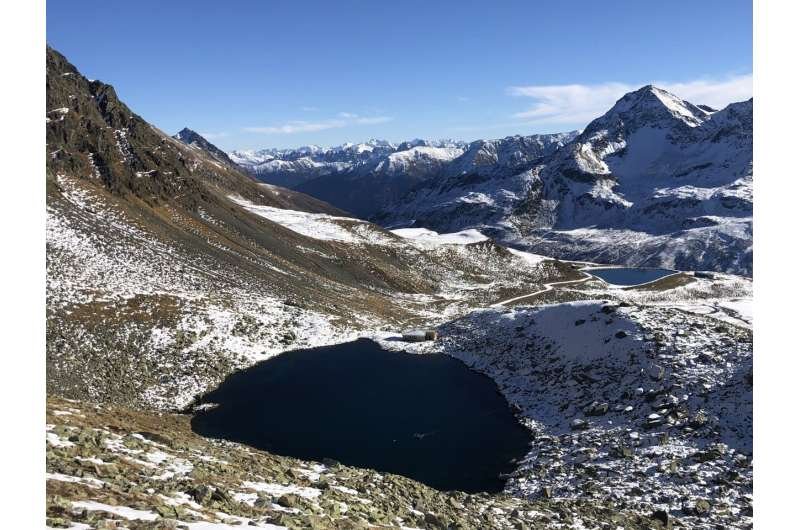
Alpine lakes are among the most harsh aquatic environments on Earth. Located at high elevation, they are exposed to intense ultraviolet radiation (UVR), wide temperature and light fluctuations, and low nutrient availability. Yet, remarkably, those ecosystems are full of life that not only survives, but thrives in these conditions. How is this possible?
This question was at the heart of my Baldi memorial keynote lecture, delivered at the 37th Congress of the International Society of Limnology. I shared new research uncovering a set of unexpected survival strategies in plankton that may also offer broader insights into freshwater and marine ecosystems facing increasing environmental stress. The lecture is published in the journal Inland Waters.
The first key topic is photoprotection or how organisms protect against the potential damage from exposure to solar UV radiation (UVR). In alpine lakes, UVR can severely damage DNA, hinder photosynthesis and disrupt cellular integrity.
It’s long been known that planktonic organisms produce photoprotective compounds like mycosporine-like amino acids (MAAs) and carotenoids to mitigate this threat. What’s new is our understanding that these defenses are not governed by UV exposure alone.
I presented data showing that nitrogen availability, water temperature and even zooplankton grazing pressure jointly determine the expression and accumulation of these compounds. This multifactorial control suggests that photoprotection is a dynamic, ecologically integrated response. It’s not just a sunscreen, it’s a finely tuned adaptation shaped by ecosystem interactions.
I believe that grasping these trade-offs is essential for forecasting how planktonic communities will respond to global drivers like warming (e.g., earlier disappearance of the ice cover), nutrient enrichment, and shifts in food web structure.
The second major recent discovery centers on microbial energy acquisition. In nutrient-poor alpine lakes, some bacteria have evolved an unusually versatile strategy called dual phototrophy. These microbes possess both aerobic anoxygenic photosynthesis machinery and rhodopsin-based proton pumps, enabling them to harvest light energy through two independent systems. This dual setup allows them to adjust to changes in light quality and intensity while maintaining energy production under carbon-limited conditions.
Interestingly, our recent work and that of marine colleagues suggests that similar mechanisms may occur in certain eukaryotic phytoplankton. If confirmed, this could redefine how we think about solar energy flow in aquatic systems, both freshwater and marine pelagic regions.
Finally, we turn to viruses, not as mere agents of death, but as unexpected players in ecosystem stability. In alpine lakes, we’ve identified novel viral groups, including Polinton-like viruses and virophages, which appear to infect and disrupt giant viruses that would otherwise kill key microbial hosts. These smaller “parasitic” viruses may act like bodyguards, indirectly protecting host populations from collapse.
This viral interference could play a pivotal role in stabilizing microeukaryote populations, influencing food web structure, and maintaining productivity in systems where even minor disruptions can have cascading effects. Understanding these multilayered virus–virus–host dynamics offers an entirely new perspective on the role of viruses in aquatic ecosystems.
Taken together, these findings underscore the remarkable adaptability of plankton under extreme environmental pressures. But more than that, they remind us that the strategies evolved in alpine lakes may be mirrored, or even amplified, in other aquatic systems facing rapid environmental change. By decoding how life endures at the margins, we gain powerful insights into the resilience, plasticity, and future trajectories of planktonic life across the globe.
This story is part of Science X Dialog, where researchers can report findings from their published research articles. Visit this page for information about Science X Dialog and how to participate.
More information:
Ruben Sommaruga, Survival strategies of planktonic organisms in alpine lakes and beyond, Inland Waters (2025). DOI: 10.1080/20442041.2025.2497248
Ruben Sommaruga is an Uruguayan/Austrian limnologist and university professor at the Institute of Ecology at the University of Innsbruck, Austria. Over the past three decades, his long-term research goals have aimed to understand how organisms adapt to the harsh environmental conditions typical of high mountain ecosystems and how lake processes are influenced by various global changes. He has studied the ecology of high mountain lakes including those affected by glacier retreat, combinig methods from limnology, microbiology, and environmental science to analyze complex ecological interactions. These studies have led to more than 160 international scientific contributions
Citation:
Unexpected survival strategies of plankton in alpine lakes have global relevance (2025, August 5)
retrieved 5 August 2025
from https://phys.org/news/2025-08-unexpected-survival-strategies-plankton-alpine.html
This document is subject to copyright. Apart from any fair dealing for the purpose of private study or research, no
part may be reproduced without the written permission. The content is provided for information purposes only.


